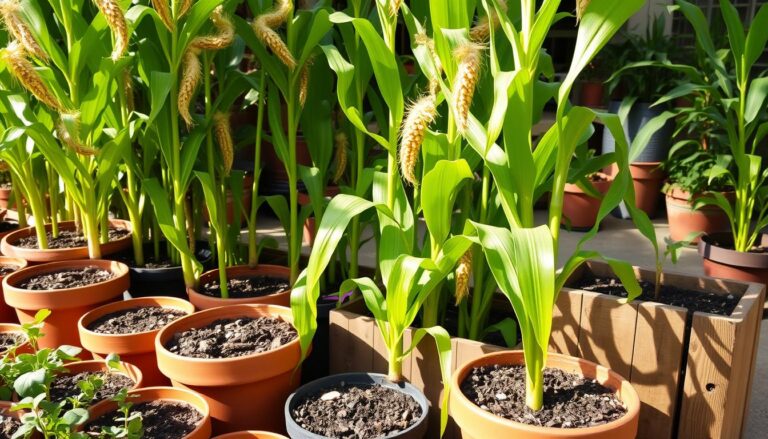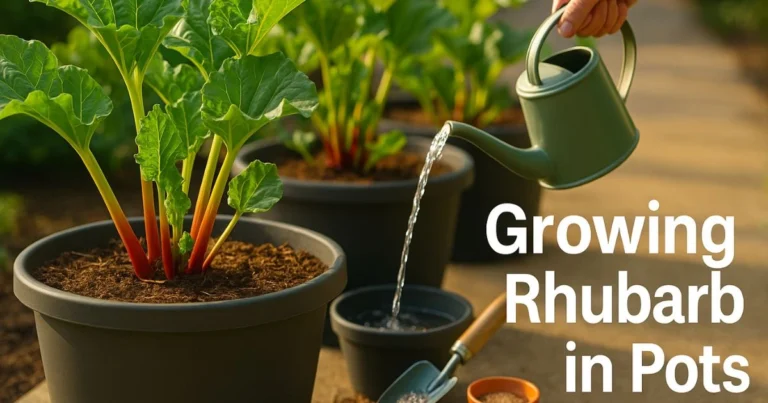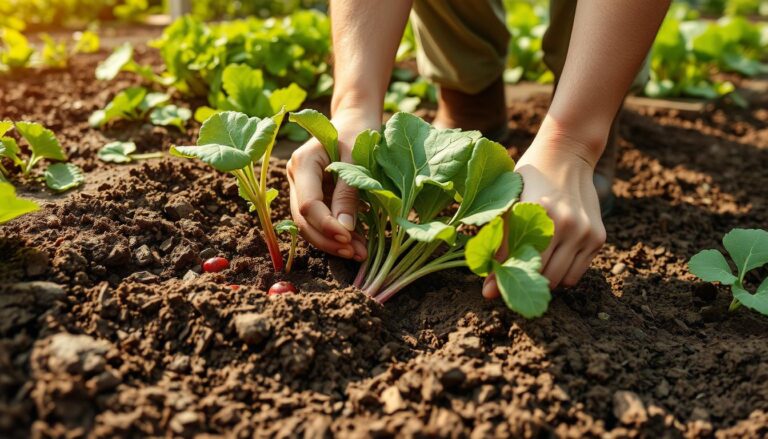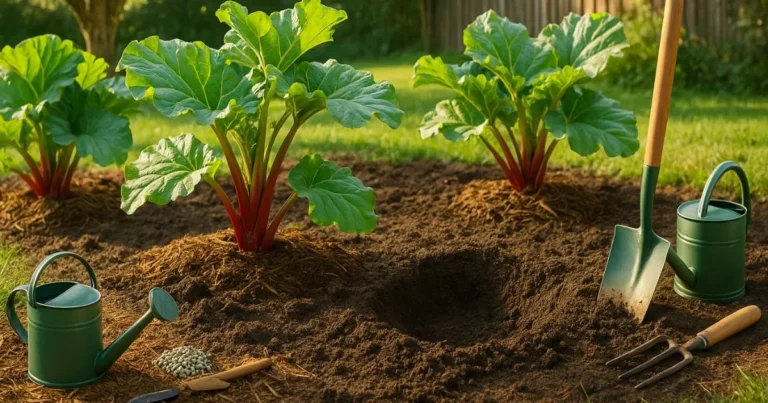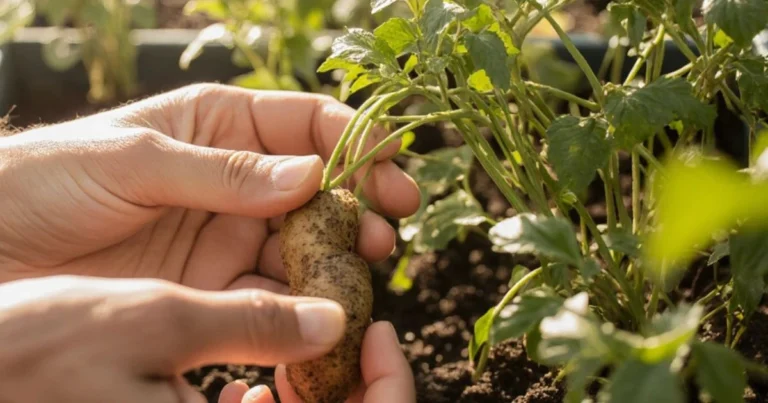Growing Peppers in Pots: Tips for a Healthy Harvest
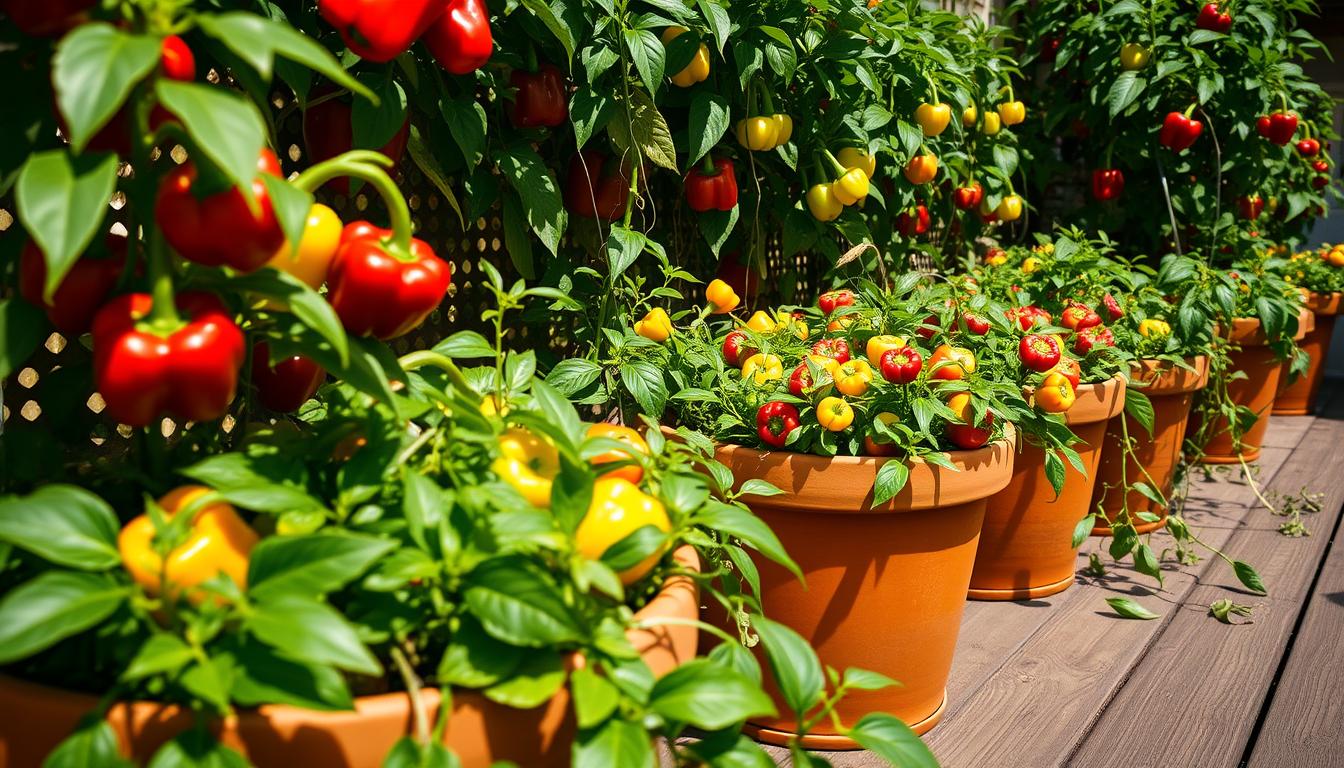
Table of Contents
Growing Peppers in Pots: Tips for a Healthy Harvest
You don’t need a big garden to grow lots of peppers. Container gardening lets you grow them even in tiny spaces. Pots help you control the soil, water, and sunlight, making a perfect spot for peppers.
Peppers in pots have many advantages. You can move them to get more sunlight or to avoid cold. This way, you can avoid diseases and pests found in soil. In this article, we’ll share tips for a great harvest. You’ll be able to enjoy fresh peppers all season long.
Benefits of Container Gardening for Peppers
Container gardening is great for growing peppers, perfect for city gardeners. It lets you control the growing conditions for your peppers. This way, you can make sure they get what they need.
Space Efficiency for Urban Gardeners
Container gardening saves space. You can grow peppers on balconies, patios, or indoors. This is great for cities where space is tight. Compact pepper varieties do well in small containers, helping you use your space better.
Mobility and Season Extension
Container gardens are easy to move. This lets you change where your plants get sunlight and warmth. You can also move them to safe places when the weather is bad. This means you can grow peppers for longer.
Better Control Over Growing Conditions
Container gardening gives you better control over soil quality and drainage. This is key for healthy peppers. You can adjust the soil to meet your peppers’ needs. This ensures they get the right nutrients and water.
Selecting the Best Pepper Varieties for Containers
Choosing the right pepper variety for container gardening is crucial for a good harvest. Look for varieties that are compact or dwarf. These are made to grow well in small spaces and produce well in pots.
Compact Varieties Ideal for Pots
Pepper varieties like ‘Mini Bell’ and ‘Thai Hot’ are perfect for containers. They are naturally smaller, with fruit that matches their size. This makes them great for pots. You’ll get high yields from these varieties, and they often need less support.
Popular Bell Pepper Varieties for Containers
Bell peppers are a hit with gardeners, and many varieties work well in containers. ‘Sweet Mini Bell’ and ‘Patio Bell’ are excellent choices. They offer sweet, crunchy peppers perfect for snacking or adding to dishes. These varieties are compact, producing plenty of fruit without taking up too much space.
Chili and Hot Pepper Varieties That Thrive in Pots
If you love spicy food, grow chili or hot pepper varieties in your containers. ‘Bird’s Eye’ and ‘Salsa Del Sol’ are popular for their intense heat and compact growth. These peppers are not only great for adding spice to your meals. They’re also relatively low maintenance and can thrive in the right container conditions.
Growing Peppers in Pots: Container Selection Guide
Choosing the right container is key for growing healthy peppers in pots. The container you pick will affect your pepper plants’ health and how well they grow.
Container Size and Depth Requirements
The size and depth of your container matter a lot for growing peppers. Your container should be at least 12 inches deep to let the roots grow well. A deeper container also holds more soil, which keeps moisture and nutrients better.
A container of at least 12 inches by 12 inches is good for most pepper types. This size gives the roots enough room to grow and supports healthy plants.
Material Considerations: Plastic, Terracotta, or Fabric?
The material of your container can change how your peppers grow. Plastic containers are light and easy to clean but might not keep roots warm. Terracotta pots are liked for being breathable and looking good but can dry out fast. Fabric pots are great for drainage and air, helping roots grow well.
Think about durability, insulation, and keeping moisture when picking a material. The best pot for peppers will mix these to create a great growing spot.
Drainage Solutions for Healthy Pepper Plants
Drainage is key to stop waterlogged soil, which can cause root rot and other issues. Look for containers with built-in drainage holes or drill your own if needed.
| Container Material | Drainage Characteristics | Insulation |
|---|---|---|
| Plastic | Good with drainage holes | Moderate |
| Terracotta | Excellent due to porosity | Poor |
| Fabric | Excellent | Good |
By picking a container that meets these needs, you’ll grow healthy and productive pepper plants in pots.
Soil Requirements and Preparation
To grow peppers in containers, you need to know about soil. Peppers like soil that drains well and is rich in nutrients. The pH should be slightly acidic to neutral.
Ideal Soil Composition for Container Peppers
The best soil for peppers in containers is a mix. You can use peat moss or compost for nutrients. Add perlite or vermiculite to improve drainage.
pH Levels and Nutrient Balance
Getting the pH right is key. Peppers do best in a slightly acidic to neutral soil, between 6.0 and 7.0. Make sure the soil has a balanced mix of nutrients. A balanced fertilizer can help.
Pre-Planting Soil Amendments
Before planting, think about adding organic fertilizers or compost. They boost the soil’s nutrient and structure.
| Soil Component | Function | Recommended Mix |
|---|---|---|
| Peat Moss or Compost | Retains moisture, adds nutrients | 40% |
| Perlite or Vermiculite | Improves drainage | 20% |
| Topsoil or Garden Soil | Provides structure | 40% |
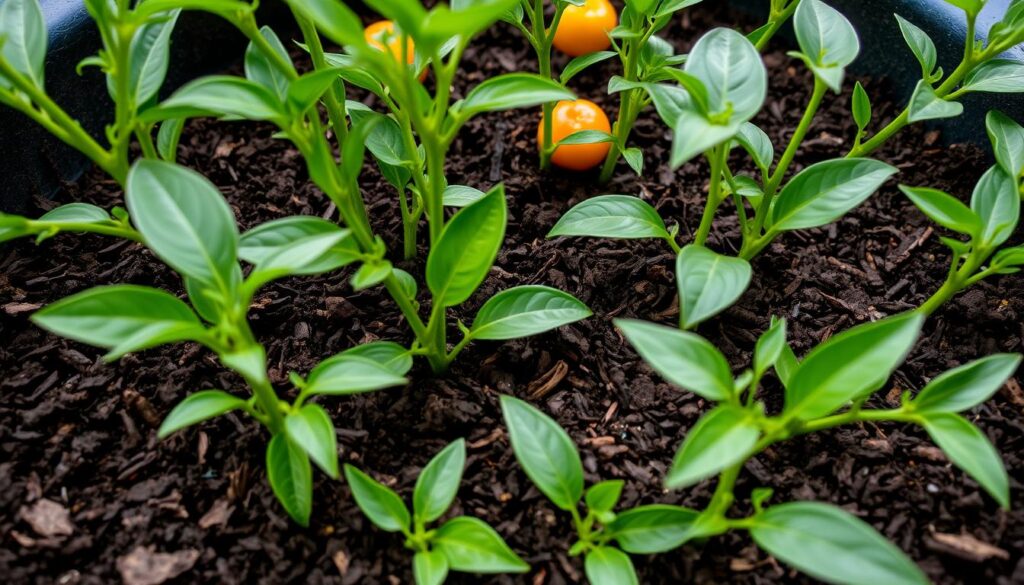
Planting Peppers in Containers: Step-by-Step Guide
To grow peppers in pots, follow this step-by-step guide. Planting peppers in containers is easy when done right.
Starting Seeds vs. Transplanting Seedlings
You can start peppers in containers two ways: from seeds or by transplanting seedlings. Starting from seeds lets you control the growing conditions. Transplanting seedlings gives you a jumpstart on the growing season.
Seed Starting Timeline
When starting seeds, plan ahead. Pepper seeds are usually started 8-10 weeks before the last frost. Here’s a simple timeline:
- Week 1-2: Sow seeds in seed starting mix.
- Week 3-4: Transplant seedlings into larger containers.
- Week 5-6: Harden off seedlings before outdoor transplanting.
Hardening Off Seedlings
Before moving seedlings outside, harden them off. This means gradually getting them used to outdoor conditions over 7-10 days. Start in a shaded area, then move them to more sunlight.
Proper Planting Depth and Spacing
When transplanting, plant seedlings at the same depth as before. Space them 12-18 inches apart for good air and growth.
Initial Care After Planting
After planting, water the peppers well. Keep the soil moist but not too wet. Watch the temperature and support the plants as they grow.
Watering Techniques for Container-Grown Peppers
Growing peppers in pots requires the right watering. Peppers need steady moisture, but too much water can harm them. Finding the right balance is key to keeping your plants healthy.
Establishing a Watering Schedule
Creating a regular watering schedule is crucial. Check the soil by inserting your finger up to the first knuckle. If it’s dry, it’s time to water. Peppers in pots need more water than those in the ground because the soil dries out faster.
Signs of Overwatering and Underwatering
Look out for signs of too much or too little water. Overwatered peppers may have yellow leaves or root rot. Underwatered plants will have wilted leaves or grow slowly. Adjust your watering based on these signs and consider weather and soil type.
Water Conservation Methods for Potted Peppers
To save water, use mulch on your container soil. Mulch keeps moisture in, stops weeds, and controls soil temperature. Also, drip irrigation or soaker hoses deliver water right to the roots, cutting down on evaporation and runoff.
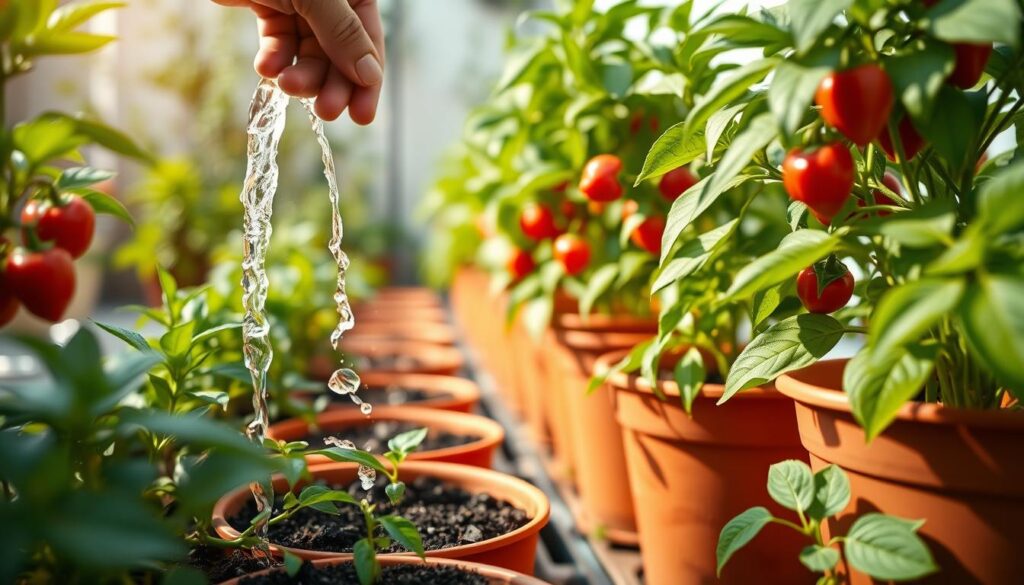
Fertilizing Your Potted Pepper Plants
Fertilizing your potted pepper plants is key to a successful garden. It helps them grow healthy and produce more fruit. Knowing the right fertilizers and how to use them is important for a good harvest.
Organic vs. Synthetic Fertilizer Options
You can choose between organic or synthetic fertilizers for your peppers. Organic fertilizers like compost or manure feed plants slowly and make the soil better. Synthetic fertilizers give nutrients fast but can harm the soil if used too much.
Fertilizing Schedule Throughout the Growing Season
It’s important to fertilize your peppers regularly. Start with a balanced fertilizer (like 10-10-10 NPK) when you plant them. When they start to produce fruit, switch to a fertilizer with more phosphorus to help with fruiting.
Avoiding Fertilizer Burn in Container Plants
Fertilizer burn is a big problem in container gardens. To prevent it, follow the fertilizer instructions and might want to dilute it. Watch how your plants react to the fertilizer too.
| Fertilizer Type | Benefits | Precautions |
|---|---|---|
| Organic | Improves soil structure, slow release | May be slower acting |
| Synthetic | Quick nutrient uptake | Risk of overuse, harm to soil organisms |
How to Grow Peppers Indoors
To grow healthy pepper plants indoors, you need to create the right environment. This includes proper lighting, temperature, humidity, and pollination.
Lighting Requirements for Indoor Peppers
Peppers need enough light to grow and produce fruit. You can use natural or artificial light to meet this need.
Natural Light Solutions
Placing pepper plants near a south-facing window is a good start. But, natural light might not be enough, mainly in winter.
Artificial Lighting Options
Grow lights can help fill the light gap. LED grow lights are great because they’re energy-efficient and emit the right wavelengths for plants.
Temperature and Humidity Control
Peppers do best in temperatures between 65°F to 75°F (18°C to 24°C) during the day. At night, they prefer it a bit cooler.
Temperature Control Tips:
- Keep plants away from drafts and heating vents.
- Use a thermometer to monitor the temperature.
Pollination Techniques for Indoor Plants
Indoor pepper plants often need help with pollination. You can use a small, clean brush to gently vibrate the flowers. Or, simply blow on them to mimic wind.
Here’s a summary of the key factors for growing peppers indoors:
| Factor | Ideal Condition |
|---|---|
| Lighting | Sufficient natural or artificial light |
| Temperature | 65°F to 75°F (18°C to 24°C) |
| Humidity | Moderate to high humidity |
| Pollination | Assisted pollination using a brush or air flow |
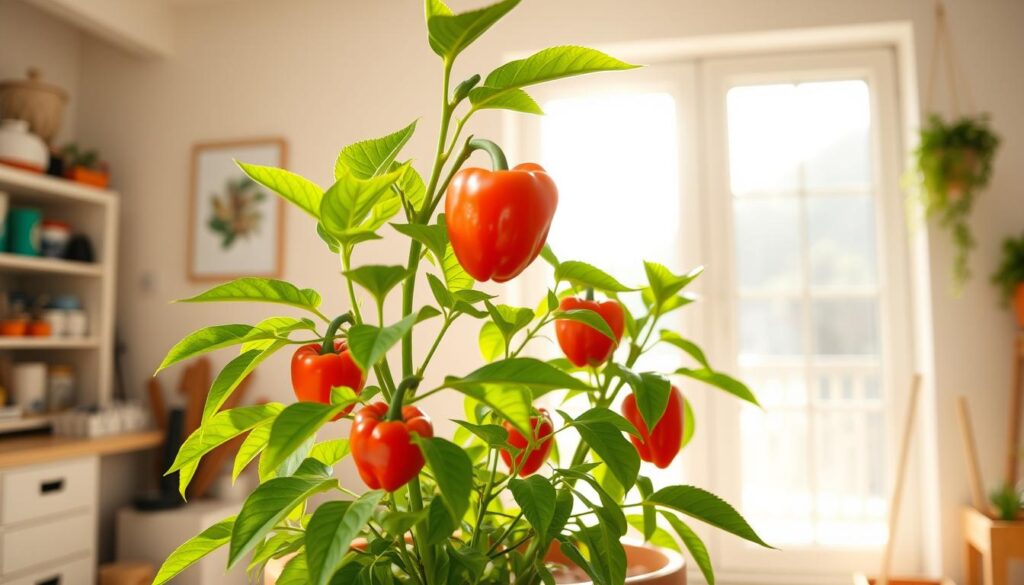
Managing Pests and Diseases in Container Peppers
Container-grown peppers face pests and diseases. It’s crucial to know how to manage them. Understanding common issues is the first step.
Common Pepper Plant Pests and Prevention
Pepper plants in containers can get pests like aphids, spider mites, and whiteflies. To stop pests, check your plants often and keep things clean. Use neem oil or insecticidal soap to fight aphids and other pests. Prevention is key to stop pests from spreading.
- Inspect plants regularly
- Use neem oil or insecticidal soap
- Maintain good hygiene
Disease Identification and Treatment
Diseases like fungal infections, bacterial leaf spot, and root rot can hit container peppers. Proper identification is key for treatment. Look for signs like yellow leaves, black spots, or soft, rotting stems. Fungal diseases need fungicides, while bacterial ones might need removing affected parts.
Natural and Chemical Control Methods
There are natural and chemical ways to fight pests and diseases. Natural methods include introducing beneficial insects, using barriers, and rotating crops. Chemical controls use pesticides and fungicides. It’s important to pick the right product and follow the instructions to protect your plants and the environment.
- Choose the right control method
- Follow product instructions
- Consider environmental impact
Troubleshooting Common Issues with Potted Peppers
When you care for your potted peppers, you might face some common problems. But don’t worry, these can be fixed with the right steps. With the right help, you can overcome these issues and get a great harvest.
Leaf Problems: Yellowing, Curling, and Spots
Yellow or curled leaves on your potted peppers often mean you’re watering too much or too little. Check the soil by sticking your finger in it up to your knuckle. If it’s dry, it’s time to water. Leaf spots can be a sign of a fungus; cut off the bad leaves and use a fungicide if needed.
Blossom Drop and Poor Fruit Set
Blossom drop can happen due to temperature changes or not enough pollination. Make sure your peppers stay at a steady 65-75°F (18-24°C). If indoors, gently shake the plants to help pollination.
Stunted Growth and Nutrient Deficiencies
Stunted growth might be from not enough nutrients or bad soil. Use a balanced fertilizer to give your plants what they need. Also, check your soil’s pH level. It should be between 6.0 and 7.0 for best growth.
Conclusion: Enjoying the Fruits of Your Container Pepper Garden
You’ve learned how to grow peppers in pots. This includes picking the right varieties and handling pests and diseases. With the right care, your peppers can grow well and give you a lot of harvest.
Container gardening is great for growing peppers in small or odd places. It’s perfect for city gardeners.
When you pick peppers from your garden, remember they need ongoing care. Make sure to water, fertilize, and prune your containers. This will help your peppers keep growing.
Container gardening is fun for both new and experienced gardeners. With the right care, you can enjoy a tasty and healthy harvest from your pepper garden.


